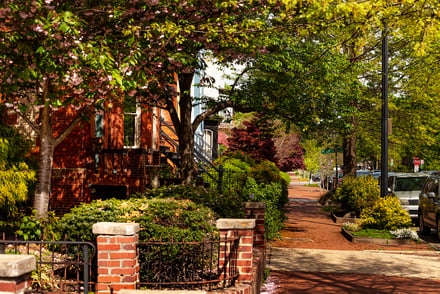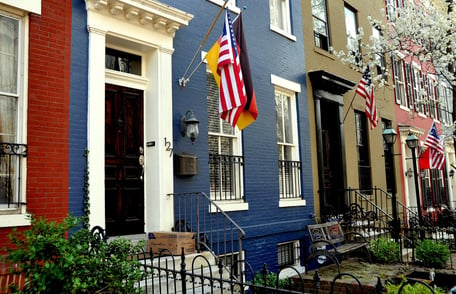Brick exteriors are some of the most resilient and long-lasting for homes. The natural, warm luster of diverse color tones resulting from brick’s raw materials create charming facades that homeowners look for on a historic home. On the other hand, adding color can enhance historic curb appeal, possibly adding to your home’s resale value. There are several points to weigh when deciding to paint your historic brick home.
Painting Your Exterior Brick- PROS
There are some clear positives about adding paint color to your brick home exterior. Here are a few:
- Affordable facelift – Painting can be relatively inexpensive, even with brick cleaning and painting prep included, while still creating a massive impact on the look of your home. You may also consider painting only the front facade and leaving the rear or an exposed side unpainted. This would add to affordability.
- Curb Appeal – Going from tired, faded or darkened bricks to fresh, any number of paint colors can make your revived home stand out in the best way in your neighborhood.
- Unlimited color choices – Regardless of your bricks and mortar color, material, or shape, you can choose from a limitless palette of color, including darker or brighter colors or any variation of white. Paint colors alone can drastically transition your home’s style, adding drama, elegance, or simplicity, or create the look of a particular geographical area or period.
- Digital previews – You can download a photo of your home into software that can reproduce the house in the exact shade you plan to buy. This chance to visualize your idea gives you a nearly accurate preview of the outcome before committing yourself to a specific color.
Painting Your Exterior Brick- CONS
It’s essential to consider the downsides of painting the exterior of your historic brick home before you jump in. Here are some cons:
- Long-term commitment – Once you paint your house, it’s tough to reverse. If you ever choose to go back to the natural brick, it could be costly.
- Moisture issues – Painted brick has a danger of not allowing moisture to escape the brick well enough, and ultimately can cause damage. It’s essential to use all the proper porous primers and paint, so brick painting should be done by professionals for that reason alone. Even then, moisture may become an issue down the road.
- Higher maintenance – Painted surfaces show dirt, mildew, and grime more easily, so you’ll need to do a regular but careful power washing. Repainting should also be done every 5-7 years.
Other Considerations When Painting Your Historic Brick Home
- Neighboring homes – Before you decide to paint your historic brick home, take a walk through your neighborhood. Your home color should complement other paint colors in the same visual “block.” Also, consider, would yours be the only painted home in a block of brick? How would that look?
- Authentic color choice – For historical continuity, you might choose to research what paint colors were common or popular when your home was built.
- Other pigments – If a painted facade doesn’t fit the neighborhood you live in, or the cons of painting are an issue for you, consider staining your brick with a special pigment. The stain will allow the natural organic brick patina to show through while still giving a fresh look.
If you’re considering improvements for your brick exterior, our Renaissance Development professionals can assist you in choosing the best treatments for the preservation and beautification of your historic brick home. Get in touch to schedule your consultation today.
1/14/21 10:51 AM

